VOLUME WITH CROSS SECTION PERPENDICULAR TO X AXIS
We can use definite integrals to find volume of a solid with specific cross sections on the interval.
For example, cross section may be any one of the shapes given below.
Squares, rectangles, semicircles, triangles etc.
If the cross section is perpendicular to x-axis and its area is a function of x, say A(x), then the volume V of the solid on [a, b] can be found using the formula
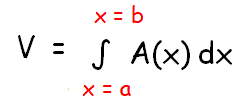
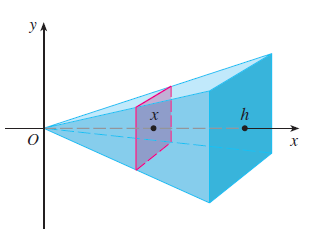
If the cross section is perpendicular to y-axis and its area is a function of y, say A(y), then the volume V of the solid on [a, b] can be found using the formula
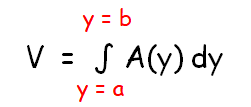
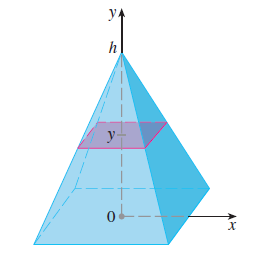
Example 1 :
Find the volume of the solid whose base is bounded by the circle
x2 + y2 = 4
the cross sections perpendicular to the x-axis are squares.
Solution :
Since the cross sections are perpendicular to x axis, we should express the area in terms of x.
Deriving the value of y from the given equation, we get
y2 = 4-x2
y = √4-x2
The cross sections are squares. So, A(x) = Area of square.
Area of square = a2
(Where a is a side length of square).
Note :
Cross sections are perpendicular to x axis, so to find length of square, we derive the given equation in terms of x.
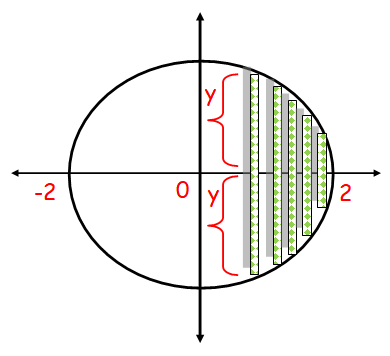
Side length of square = 2y
2y = 2√(4-x2)
Area of square :
A(x) = (2y)2 ==> (2√(4-x2))2
A(x) = 4(4-x2)

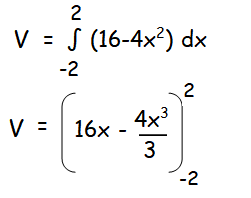
= 32 - (32/3) - (-32+(32/3))
= 32 - (32/3) + 32-(32/3)
= 64 - 64/3
= (192-64)/3
= 128/3
Example 2 :
The base of S is the region enclosed by
y = 2-x2
and the x-axis. Cross-sections perpendicular to the y-axis are quarter-circles.
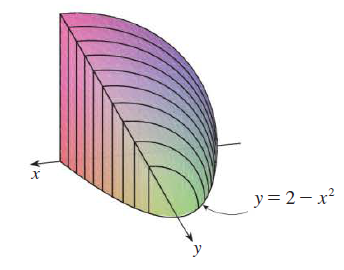
Solution :
Cross sections are perpendicular to y axis and we have to derive the given function in terms of x.
y = 2-x2
x2 = 2-y
x = √(2 - y)
2x = 2√(2 - y)
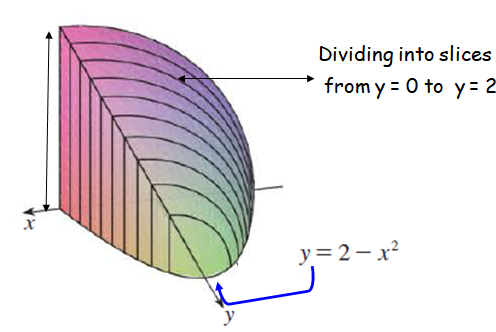
Radius of quarter circle = r = 2x
Area of quarter circle = (1/4) πr2
A(y) = (1/4) π(2√(2 - y))2
A(y) = π(2 - y)
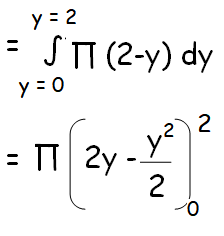
= π [4-(4/2)]
= 2π
Example 3 :
For each problem, find the volume of the specified solid. The base of a solid is the region enclosed by y = 1 and y = x2. Cross-sections perpendicular to the y-axis are squares
Solution :
Cross sections are perpendicular to y axis and we have to derive the given function in terms of x.
y = x2
x = √y
Side length = √y + √y
= 2√y
Area of square :
A(x) = (2√y)2
= 4y
= Integral 0 to 1 (4y) dy
= (4y2/2)
Applying the limits, we get
= 2y2
= 2(1)2 - 2(02)
= 2
So, the required volume is 2 cubic units.
Example 4 :
For each problem, find the volume of the specified solid. The base of a solid is the region enclosed by y = 1 and y = x2. Cross-sections perpendicular to the y-axis are squares
Solution :
Cross sections are pe
Kindly mail your feedback to v4formath@gmail.com
We always appreciate your feedback.
©All rights reserved. onlinemath4all.com
Recent Articles
-
Digital SAT Math Problems and Solutions (Part - 150)
Apr 25, 25 11:46 AM
Digital SAT Math Problems and Solutions (Part - 150) -
AP Calculus AB Problems with Solutions (Part - 19)
Apr 24, 25 11:10 PM
AP Calculus AB Problems with Solutions (Part - 19) -
AP Calculus AB Problems with Solutions (Part - 18)
Apr 24, 25 11:06 PM
AP Calculus AB Problems with Solutions (Part - 18)
